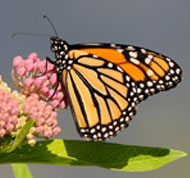Milkweed plants support a community of diverse creatures that depend on each other for food, shelter and protection. Many insects are attracted to the nectar and pollen found in the fragrant flowers. Others make a meal of the leaves, stems, buds, sap and roots. The nectar and leaf eaters attract predatory insects and arachnids.
The best time to gather milkweed seed is in early fall, within one or two days of the pod opening.
Contact Volunteer Services to find out how you can get involved with the seed collection happening in 2016. Email volunteerservices@metroparks.org or call (937) 275-PARK.



